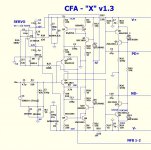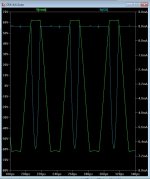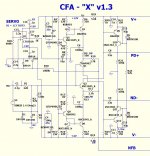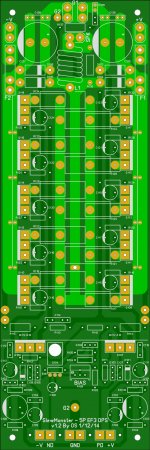The IPS's can just be done by the individual via toner transfer / photographic methods as desired. I don't plan on having any IPS's manufactured at the moment. Since the OPS is common to all it makes sense to have that done professionally. If a particular IPS shines and is in demand then that could be done professionally too. You are right though, a few need to be built and listened to to see which ones, if any, have a 'superior' sound.
Being silly ....
😉
Have another IPS ... ha ha ..
Take the old "VSSA" , "hide" it behind current mirror's ... add a
servo/voltage controlled dual CCS and Hawksford ....
And get a 15ppm , nV offset , -90db PSSR REAL amp ( ips).
No trimmers ... No worry. (below)
Bimo spoke of this , Miib (on the CFA thread) simulated it. Mine
is different , of course .... but it "flies" . 😀
OS
😉
Have another IPS ... ha ha ..
Take the old "VSSA" , "hide" it behind current mirror's ... add a
servo/voltage controlled dual CCS and Hawksford ....
And get a 15ppm , nV offset , -90db PSSR REAL amp ( ips).
No trimmers ... No worry. (below)
Bimo spoke of this , Miib (on the CFA thread) simulated it. Mine
is different , of course .... but it "flies" . 😀
OS
Attachments
I still say with speaker distortion being <100x or more these distortion numbers that is just a foolish thing to chase in the end.
I discussed this before ...
An amp that "flies" (ultra low thd , good clipping ...) is also
one that will last 20 years and give beautiful sound whether
used normally or pushed hard.
The standard VSSA which I "murdered" in my last post has
a enormous THD rise as you approach the rails.
This might come across as an amp that might not be
"effortless" or "have authority" upon being driven hard.
#1 for me is the "hardiness" of the circuit ... usually low
THD comes along with this.
OS
OS,'
I agree that an amplifier that last for years should be something that we would all want. Who wants and amp that is running so close to the edge that is has a limited lifespan?
I have nothing against low distortion, just there seems to be a point of diminishing returns where complexity just goes up on a rapid rate and the question becomes does it actually sound better? If you think that this latest CFA-X would sound much better than the earlier version then go for it.
I just am waiting for some listening tests, and even then that is so subjective as everybody has such different speakers and tastes in sound.
I agree that an amplifier that last for years should be something that we would all want. Who wants and amp that is running so close to the edge that is has a limited lifespan?
I have nothing against low distortion, just there seems to be a point of diminishing returns where complexity just goes up on a rapid rate and the question becomes does it actually sound better? If you think that this latest CFA-X would sound much better than the earlier version then go for it.
I just am waiting for some listening tests, and even then that is so subjective as everybody has such different speakers and tastes in sound.
You mean in parallel with the 22u already at the OP devices? Just want to be clear on what you mean.
Hey, I was curious to get your official opinion on my efforts. I hope I'm not stepping on your toes here. If I am, just tell me to step off.
No, instead of them ... or the option to use either (multi-pitch).
The wima's are 3.5mm or 5mm LS.
I like the way you inject the servo adjustment through a cascode. Very clever adaptation.
Now I suspect that you have performance close to my implementation. Problem is "sorry to say this, that it gets creamed by Sonny's TSSA.
Now I suspect that you have performance close to my implementation. Problem is "sorry to say this, that it gets creamed by Sonny's TSSA.
OS,
Are there any advantage to the square caps you are talking about in regards to the shape or are they just good caps that happen to be square? I assume most people use lytic caps for their small size compared to a film cap of the same value, I would prefer to use film any time it is practical over lytics.
Are there any advantage to the square caps you are talking about in regards to the shape or are they just good caps that happen to be square? I assume most people use lytic caps for their small size compared to a film cap of the same value, I would prefer to use film any time it is practical over lytics.
OS,'
I agree that an amplifier that last for years should be something that we would all want. Who wants and amp that is running so close to the edge that is has a limited lifespan?
I have nothing against low distortion, just there seems to be a point of diminishing returns where complexity just goes up on a rapid rate and the question becomes does it actually sound better? If you think that this latest CFA-X would sound much better than the earlier version then go for it.
I just am waiting for some listening tests, and even then that is so subjective as everybody has such different speakers and tastes in sound.
It most likely would not sound better under normal use.
It would , however be more likely to stay "precision" at wide
ambient variables and age.
The VAS would also be a better match for these big OPS's.
We are not running 35-50V rails for these OPS's ... but up to 90V.
The Hawksford and the symasui VAS also have superior overload (clip)
behavior.
As far as the speakers - I like my tweeters ... A badger -like IPS
has a real high harmonic content when clipped.
These symmetrical VAS's have nearly rounded edges at overload
(H2 mostly) .. 🙂
Complexity --- a few added to-92's/LED's are indeed a real deal ,
not costly - as compared to new tweeters. 😀
The original luxman (w/hawksford) I repaired was 25 YO , student's "partied" with it ..
most likely clipped the hell out of it during "binges" - the hawksford
and their cheap tweeters were still working.
OS
Last edited:
No, instead of them ... or the option to use either (multi-pitch).
The wima's are 3.5mm or 5mm LS.
Ah, gotcha. I've always bought those little box caps in 5mm LS, never bothered with the 3.5mm LS. The reason I took out the multi-pitch was a DRC complaint about the holes being too close, though going to 35 thou holes would prevent that. If you feel it is of real benefit to have the added LS options there then it is easy enough to put the pads back.
OS,
Are there any advantage to the square caps you are talking about in regards to the shape or are they just good caps that happen to be square? I assume most people use lytic caps for their small size compared to a film cap of the same value, I would prefer to use film any time it is practical over lytics.
Those poly caps can take the switching pulses at the OP collectors
more easily. Electrolytic' s will work , but the poly's will last forever.
(much more durable).
OS
I am going to assume right now that the components that cause the drift over time are the electrolytic capacitors. How does a VAS keep things better over time. just in the feedback circuit working harder to keep working correctly or is there some advantage to the feedback circuit over the CFA's feedback topology?
Another cap option --- SMD 1-2.2uf @ 100V.
http://www.mouser.com/ds/2/400/CGA6N3X7R2A225K230AB-266176.pdf
They are 3.2mm long - automotive grade 150C.
OS
http://www.mouser.com/ds/2/400/CGA6N3X7R2A225K230AB-266176.pdf
They are 3.2mm long - automotive grade 150C.
OS
I am going to assume right now that the components that cause the drift over time are the electrolytic capacitors. How does a VAS keep things better over time. just in the feedback circuit working harder to keep working correctly or is there some advantage to the feedback circuit over the CFA's feedback topology?
No - a better VAS will
-save tweeters with better clipping behavior.
-1/10th the load on the IP pair.
-Saturation of the cascode stays there ...
(below) is the load that the vssa input pair sees at clip. In a CFB amp ,
"current on demand" tries to provide the I.
Bimo/NAF say that the IP pair heat up when clipped at high levels (abuse).
Here we can reduce this load.
PS- it's worse on the non-hawksford ... 15-20ma !!
The servo/ccs/CM will offset most effects of any component aging/ambient
changes.
OS
Attachments
I like the way you inject the servo adjustment through a cascode. Very clever adaptation.
Now I suspect that you have performance close to my implementation. Problem is "sorry to say this, that it gets creamed by Sonny's TSSA.
Thanx ..Miib.
I won't "stroke the cat" for that last comment. 😀
His uses all sorts of stupid Jfets and IGBT's ... they all can have it. 🙁
I'm satified with 90db psrr/15ppm/good clip/1mv offset , all
with junkbox parts.
OS
Oh well ...
I seem to get criticized for moving things along ... but if
I bother to print out an IPS ... it must "fly".
It (the 1.3) should sound the same , or better on a single PS (psrr).
The extra 2 devices on each half (CM's) are just 1.00$ and should take
up no space. Adding a servo is just like adding TL431's on the "TSSA" 🙄.
The whole amp goes to 80V rails with ease , the servo is better than
the nad - AND it's still a VSSA .... nothing new in the signal path besides
the hawksford.
Build it out of e-waste , it will still "fly".
.asc + schema below -
OS
I seem to get criticized for moving things along ... but if
I bother to print out an IPS ... it must "fly".
It (the 1.3) should sound the same , or better on a single PS (psrr).
The extra 2 devices on each half (CM's) are just 1.00$ and should take
up no space. Adding a servo is just like adding TL431's on the "TSSA" 🙄.
The whole amp goes to 80V rails with ease , the servo is better than
the nad - AND it's still a VSSA .... nothing new in the signal path besides
the hawksford.
Build it out of e-waste , it will still "fly".
.asc + schema below -
OS
Attachments
I seem to get criticized for moving things along ...
OS
I appreciate your efforts, OS. It doesn't matter what one does, there will always be critics. Often that is good, sometimes not.
I think I've just about gone blind looking at the 5P OPS files and have them now fully 'tweaked'. Just adjusted a few hole sizes and have reviewed very carefully. Attached is a ZIP of the Gerber / Excellon files, including my Sprint file.
I have made every effort to ensure the information posted here is accurate and correct, but I can not make any warranty if you choose to use these files. This is the package I will be using personally.
Attachments
I like the way you inject the servo adjustment through a cascode. Very clever adaptation.
Now I suspect that you have performance close to my implementation. Problem is "sorry to say this, that it gets creamed by Sonny's TSSA.
Sonny's TSSA is a very good sounding amp. It is 85% of what I want in an amp. What i strive for beyond it is a more full bodied sound and slightly more power. I have yet to hear his next version, but he says it steps up the performance in a very positive way.
buzzforb,
Please expound on what you mean by more full bodied sound please. Are you saying to change the balance of the sound or to extend the frequency response. I am always curious when someone says this, what it is they mean by more body?
Please expound on what you mean by more full bodied sound please. Are you saying to change the balance of the sound or to extend the frequency response. I am always curious when someone says this, what it is they mean by more body?
Sonny's TSSA is a very good sounding amp. It is 85% of what I want in an amp. What i strive for beyond it is a more full bodied sound and slightly more power. I have yet to hear his next version, but he says it steps up the performance in a very positive way.
I think I know the problem ... even the simulator shows it.
NAF/Bimo also reported this issue with the CFA's.
At least in the case of the VSSA ... it sucks (bass wise).
Having those virtual ground reference DC blockers at FB node is
an issue @<100hz. A similar VFA with blocker, (higher Z) does not suffer
as much.
I compromised with my last posted v1.3 , reducing CF and keeping
as large a cap as possible.
The NAD is pure DC at FB , as is the
spooky leach ... same gain/THD (<10ppm) for 5 - 100hz).
Original VSSA (and even mine) rise at LF.
But , at 20K ... they "rule" !!
Naf says the NAD rules the VSSA in bass , as well. Simulation
absolutely supports the real world assessments.
OS
I found that amp with one stage voltage gain (CFA) or two stage voltage gain (common VFA) can adjust for best sounding (subjectively) when we add right amount local feedback on VAS. But I don't know why they can sound better.
In sim, THD only change a bit and can be ignore.
In sim, THD only change a bit and can be ignore.
- Home
- Amplifiers
- Solid State
- Slewmaster - CFA vs. VFA "Rumble"



